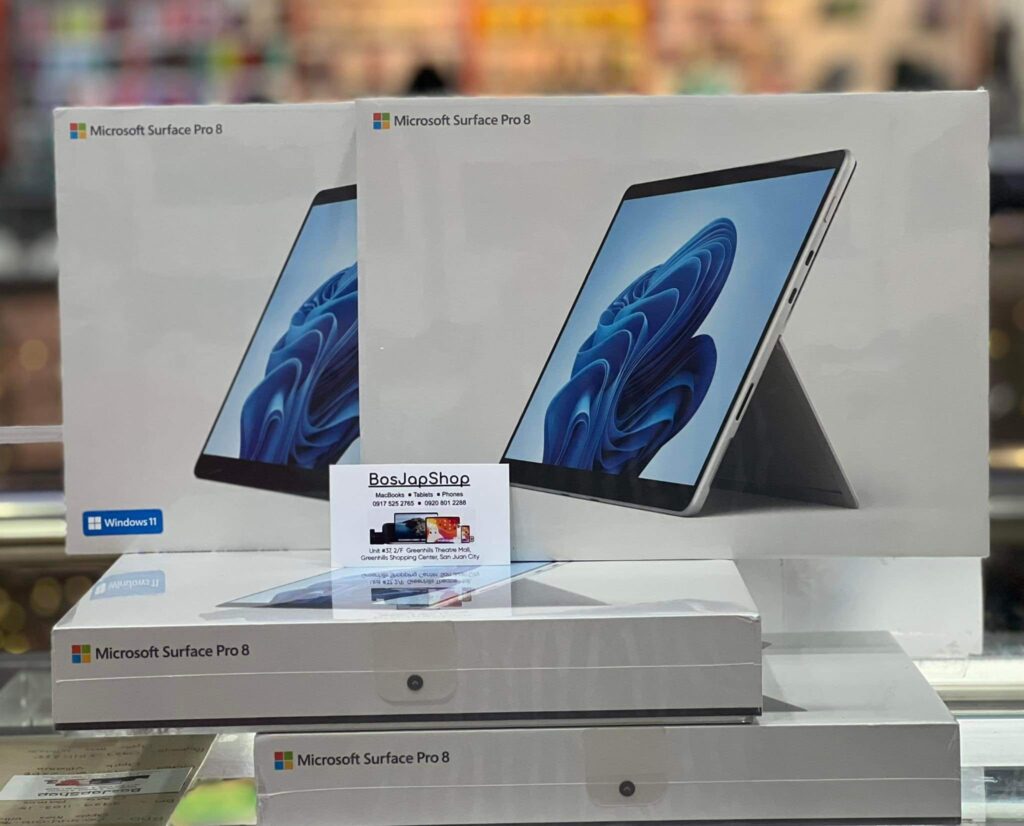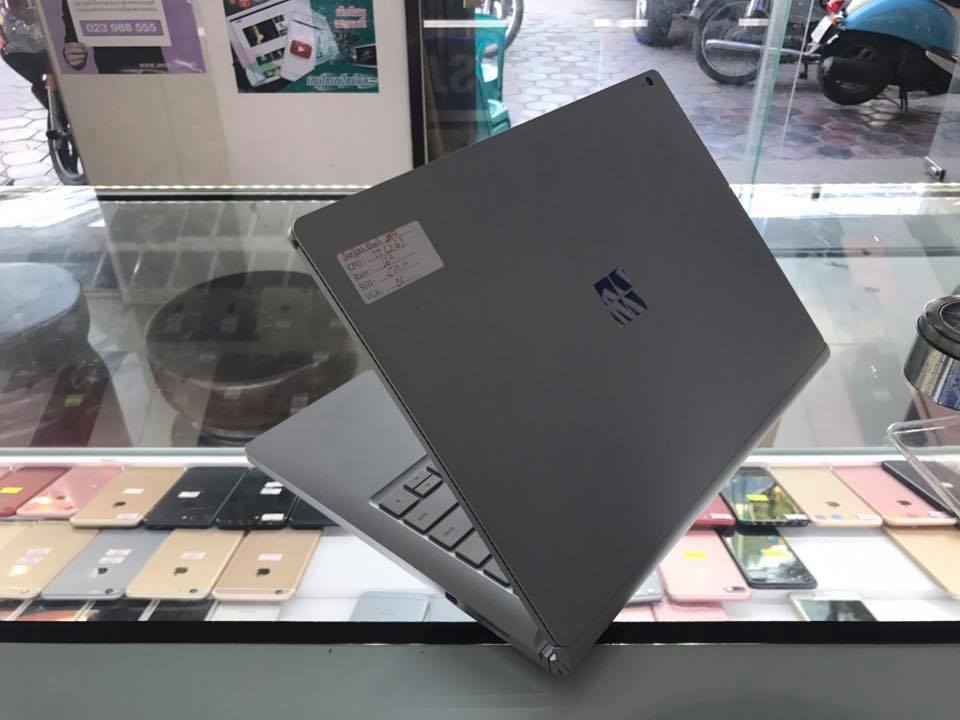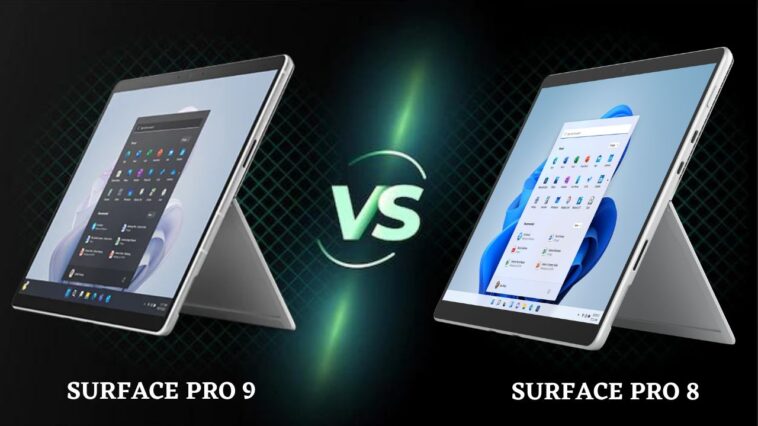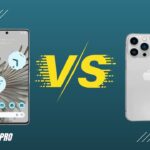Table of Contents
Microsoft has been producing Windows tablets for almost ten years, but things haven’t always gone smoothly for the business. The first-generation Surface tablet released in 2012 ran on Windows RT, a compact operating system that wasn’t well received by most consumers. However, it didn’t take long for Microsoft to become the standard manufacturer of Windows 2-in-1 devices due to the Surface Pro line.
Microsoft has ultimately confirmed the Surface Pro 9 official after months of speculation. The most recent version of the company’s top-of-the-line Windows tablet has a lot of brand-new features, including improved CPUs, the unification of the Surface Pro X range under one brand name, and even some new colors for the first time in a very long time. As the Surface Pro 8 is also a popular model in the same line, this iteration of the Surface Pro family is undoubtedly interesting. Let’s examine and contrast the Surface Pro 9 and Surface Pro 8 more closely.
Surface Pro 9 Vs Surface Pro 8: Comparison Table
| Features | Surface Pro 9 | Surface Pro 8 |
| Launching Year | 2021 | 2022 |
| Brand | Microsoft | Microsoft |
| Model Name | Microsoft Surface Pro 9 | Microsoft Surface Pro 8 |
| Series | Microsoft Surface Series | Microsoft Surface Series |
| OS | Windows 11 | Windows 11 |
| Display | 13-inch PixelSense 2880 x 1920 IPS display up to 120Hz | 13-inch 3:2 IPS 3K (2880 x 1920) |
| Graphics | Intel Iris Xe Microsoft SQ 3 Adreno (5G models) | Intel Iris Xe |
| RAM | 8GB to 32GB LPDDR5 8GB or 16GB LPDDR4x (5G model) | 8GB 16GB 32GB |
| Storage | 128GB to 1TB removable SSD 128GB to 512GB removable SSD (5G models) | 128GB PCIe(SSD) 256GB PCIe SSD 512GB PCIe SSD 1TB PCIe SSD |
| Online Pricing Range | Rs 1,03,900 | ₹84,990 |
| Customer Ratings | — | 4.5/5 |
READ MORE: LG Gram 15 (2022) Vs LG Gram 14 (2021): Which LG Device Is A Best Buy For You?
Surface Pro 9 Vs Surface Pro 8: Detailed Review
Design

Although the design and feel of Microsoft’s Surface Pro 8 were perfect, the Surface Pro 9 and 9 Pro each offer a more refined and clean appearance. It has rounded corners and no boring antenna window along the top edge on the Intel-based Pro 9 version. We appreciate Microsoft’s decision to return the power and volume controls to the top edge, where they had been on the rest of Surface Pro models up to the Pro 8. The tablet frame’s top edge is curved all the way back to the hidden kickstand, which rotates away from the body. There is now an upgradeable SSD where there used to be a micro SD slot. Even though it’s simple to take off the lid, replacing the SSD itself requires specialized tools.
The Surface Pro 9 still has a high-resolution, 13-inch Pixel Sense screen that is vibrant and brilliant. We love that the side bezels are still pleasingly minimal because it’s a fantastic showpiece for Windows 11. The 1080p Windows Hello front-facing camera is located in the center of the top bezel’s deeper border. While Microsoft didn’t replace the camera, it did tilt it four degrees downward to better fit how people sit during video conferences. The Surface Pro 9 weighs 879 grams, which is a good thing considering one of the things we enjoy the most about the Surface Pro line is its portability. The Surface Pro 8 weighed 1.95 lbs. Even with the addition of the type cover and Slim Pen 2, the portable still weighs less than three pounds.
There are just two Thunderbolt 4 USB-C connectors available. We don’t think you’ll miss USB-3, and anyway, it’s not there. Although it has been two generations since there was a 3.5mm headphone jack, you might miss one. The Surface Connect unique power port is still present. Along the corners of the screen, there are two stereo speakers that can handle Dolby Atmos. They were quite loud on the Surface Pro 8, but we were unable to test them. Additionally, there are some well-concealed twin far-field microphones. The aluminum chassis of the Surface Pro 9 and 9 Pro 5G both include a channel running around the outside edge. For the former, the high-powered Intel chip needs a true, through-the-chassis vent to help it stay cool. The channel is just surface-deep on the more energy-efficient Surface Pro 9 5G, but it is still intended to remove some system heat.
The Surface Pro 8’s design manages to be both instantly recognizable and a significant improvement. Although there are only two color options available, Platinum or Graphite, its magnesium alloy construction nevertheless looks and feels great. Added grip is provided by a matte coating, which prevents apparent fingerprint smudges. It also means that the Pro 8 is cozy to use as a tablet without a case, though at 891g, you’ll want to rest it when using it for an extended period of time. The integrated kickstand fills this role. It covers the entire width of the device’s back and allows for configurations that range from completely vertical to just slightly elevated off the table. Although there are no differences between this and the Pro 7, it feels remarkably strong and solid due to a durable metal hinge.
It is followed by some official branding and a doorway to the detachable SSD, which is only offered in 128GB and 256GB variants. The only other noteworthy element on the back of the tablet is a single 10Mp rear camera, indicating that Microsoft has maintained a minimalist design style here. Although it is a notable improvement over the 8Mp sensor on the previous Surface Pro generations, you cannot use it frequently for photography. Aside from the device’s awkwardness, stills taken with the Pro 8 are still sporadic at best. Nice pictures can be taken in good lighting situations, but exposure issues frequently arise, and dynamic range is frequently inadequate. Although possibly not much more, it is good for document scanning and reference.
Since the 5Mp front-facing lens is of reasonable quality, it is a fantastic choice for video conferences. It can record in 1080p, which is a quality that many laptop webcams still can’t match. Many Surface computers have this as the greatest strength, especially when used with two studio mics. The Pro 8 supports Windows Hello face unlock because of the separate infrared lens that is located next to it. This works incredibly well and is simple to set up; if you use spectacles, an additional scan is advised. As there is no fingerprint scanner on the tablet itself or either of the compatible keyboard coverings, it is your sole choice for biometric unlocking. Significantly narrower bezels, which enable a larger 13-inch display within essentially the same footprint, are the primary design improvement that you’ll undoubtedly notice.
On the sides of the tablet, you’ll find the power button, volume rocker, 3.5mm headphone socket, and a docking station for keyboard coverings. There aren’t many notable differences here. Microsoft continues to use its proprietary Surface Connect as the primary charging method, though you may also use one of the USB-C connections. Although the USB-A port has been eliminated, these still support Thunderbolt 4 for quick data transfer. If you’re anything like us, that means frequently attaching an adapter or hub; it feels like an additional factor. If you’re anything like us, that means frequently attaching an adapter or hub; it feels like an additional factor.
Accessories

The Surface Pro 9 and Pro 9 5G do not ship with the Surface Keyboard or Slim Pen 2; however, we are heard of very few users who do so. We used the keyboard a little bit, and it worked just like we thought. Microsoft modified the haptics a little to better simulate the sensation of drawing with a real pen or pencil on paper, but the Slim Pen 2 still has the same design. Both the Surface Pro 9 and Surface Pro 9 5G were used for drawing, and we must say that the ultra-smooth screen made it feel like we were sketching on paper. We kind of liked it and were happy to discover that the haptics is also customizable. Unfortunately, Microsoft continues to sell each of the Surface Pro 8 accessories individually, even though the majority of customers consider the keyboard to be a necessity.
But at least the company is pairing the newest Signature Keyboard with the Slim Pen 2. Even the stylus has its own built-in charging station and storage space above the keyboard. Especially because this new design keeps the pen out of the way when you just want to type, We prefer this to a pen that automatically attaches to the top of the tablet. However, the Slim Pen 2 differs significantly from several earlier Surface styluses. Along with a physical button that may be utilized for rapid access to particular tools, it adopts a flatter design that We felt to be more natural for writing. With just one click, you may launch the Microsoft Whiteboard application, where the pen’s tip can also be used as a virtual rubber. A screenshot can be edited by double-clicking, but everything can be customized in Settings. Automatic Bluetooth pairing is available, and during our testing period, We experienced no input lag. Palm rejection is also very good; however, We are unable to confirm Microsoft’s claim that it supports 4096 different levels of pressure sensitivity.
Given the size of the Surface Pro 8, a full-size keyboard can now fit inside with no problem. A proficient typing experience is provided by the Signature Keyboard, equal to that of the Surface Laptop 4. Although backlit keys offer a significant advantage over other competitors, both are covered in a soft-touch Alcantara fabric. Additionally, a relatively large touchpad that supports the entire set of motions offered by Windows 11 is much more usable. Nevertheless, for prolonged sessions, We still advise using a Bluetooth mouse.
READ MORE: Asus ROG Strix Scar 15 Vs ROG Strix G15: Which One Is The Best Buy?
Display
These devices now mostly share the same characteristics as before due to the Surface Pro 9’s availability with both Arm and Intel processors; however, the 5G model offers a noticeable display improvement over the Wi-Fi model. It has a display with a dynamic refresh rate and up to 120Hz because of the enhancements Microsoft made to the Surface Pro 8 in 2021, making animations and motion look even smoother. Additionally, the Surface Slim Pen 2’s tactile signals and other capabilities are supported by this panel. It’s fantastic to see this type of haptic feedback, which Microsoft utilizes to imitate the feel of a pen on paper, available on the Arm-powered model as well because we found it to function incredibly well in devices from a year ago. However, other functions, such as compatibility with Dolby Vision IQ and Auto Color Management, are still unique to the Intel model.
Although the display on the Surface Pro 7 wasn’t particularly bad, Microsoft has prioritized improving it. The screen size has increased from 12.3 to 13in, but it still maintains a 3:2 aspect ratio. In spite of the fact that this “PixelSense Flow” display is still LCD and not OLED, it now has a new 2880 x 1920 resolution. However, the 120Hz refresh rate is the real game-changer here. It’s the first Microsoft computer to go above 60Hz, along with the Surface Laptop Studio; however, you’ll have to manually adjust it in Settings. It provides a snappy, silky-smooth experience that is probably even more amazing on desktop computers than on smartphones.
At the launch of Windows 11 in 2021, Microsoft promoted the Dynamic Refresh Rate (DRR) feature, which would enable the Surface Pro 8 and a few other devices to automatically modify the refresh rate in response to the environment. Dual 2W stereo speakers continue to be included in the Pro 8, and they are emitted through sizable grilles on either side of the device. They produce powerful, deep sounds that you might not anticipate from a device of this size.
Specs & Performance
The Surface Pro 9’s availability with either Intel or Arm-based CPUs is, in fact, as we’ve already noted a few times, maybe the biggest news about the device. Instead, we have the Surface Pro 9 Wi-Fi variant, powered by Intel CPUs, or the Surface Pro 9 with 5G, powered by the Microsoft SQ3 processor based on the Qualcomm Snapdragon 8cx Gen 3. Microsoft is no longer differentiating the ordinary Surface Pro family from the Surface Pro X. Additionally, and both models have been significantly improved over their predecessors. The Surface Pro 9 Wi-Fi model now has CPUs from the 12th generation of Intel, which is a significant improvement over the previous generation.
Thanks to Intel’s new hybrid architecture, these new versions have ten cores and 12 threads, compared to the Surface Pro 8’s four cores and eight threads. Similar to CPUs based on Arm, there is a mix of performance and efficiency cores. In contrast, the Surface Pro 9 with 5G is an even greater improvement over earlier Surface Pro X models. The Microsoft SQ3 is built on the Qualcomm Snapdragon 8cx Gen 3 processor, which provides significant performance improvements over the previous generation. Qualcomm claims that its chips run 85% faster on the CPU and 60% faster on the GPU than the Snapdragon 8cx Gen 2, which is a significant improvement and may help to explain why Microsoft is grouping these products under a single product line. The Surface Pro 9 offers compatibility with 5G cellular connectivity, which we have already highlighted. This is another significant improvement. Since its launch in 2019, the Surface Pro X has mostly supported LTE; however, it was never upgraded to 5G. Finally, it’s happening, and Microsoft is actually going above and beyond to make mmWave support available in a few markets.
There aren’t many laptops that support mmWave 5G, mostly because no Intel-powered devices can. Because Arm CPUs are found in the few laptops that support mmWave 5G, Microsoft was also successful in this area. Naturally, you’ll still receive sub-6GHz 5G, in addition to support for LTE networks in areas where mmWave 5G isn’t offered. However, there are no longer any Surface Pro 9 devices powered by Intel that allow cellular connectivity now that there is a dedicated model available. It is necessary to get the Arm-based model if you want LTE or 5G.
Every Surface Pro generation has had updated internals, and this one is no exception. The Pro 8 runs on Intel’s 11th-generation processors, despite the fact that it was released before the company unveiled its most recent CPUs in January 2022. Both the Core i5-1135G7 and Core i7-1185G7 are available here; however, We can only speak to the latter. Performance is, as expected, good on this mid-spec device with Iris Xe integrated graphics and 16GB of RAM. When it comes to the most popular productivity tasks, such as web browsing, email checking, video calls, and multitasking, the Pro 8 excels. Even having many apps running at once, there was never any stuttering, hesitating, or app crashes during our time with the tablet. But in these circumstances, you’ll notice that the device’s back feels warm to the touch.
But when you do that, you’ll also see the fans turning on. More demanding use cases like light gaming and video editing are also possible. Although it doesn’t get too loud, this can occasionally be annoying. One of the first devices to ship with Microsoft’s operating system out of the box was the Surface Pro 8, which debuted around the same time as Windows 11. Although Surface devices aren’t given an advantage over other Windows manufacturers, it is one of the first in line for new updates. Since its release, Microsoft has addressed many of the problems with Windows 11, but it still has a drastically distinct appearance and feels from Windows 10. Additionally, there is no tablet mode, which makes touch input feel less natural than cursor-based navigation. It’s still functional, but if you’ve never used Windows 11, you’ll need to be patient and get used to its quirks. However, recent advancements imply Microsoft is prioritizing touch input, so in a few months, it might seem much more optimized.
Surface Pro 9 Vs Surface Pro 8: Quick Results
| Particulars | Surface Pro 9 | Surface Pro 8 | Which One Is Better? |
| Design | Better | Good | Any |
| Accessories | Better | Good | Surface Pro 9 |
| Display | Better | Good | Surface Pro 9 |
| Specs & Performance | Better | Good | Surface Pro 9 |
Final Verdict: Surface Pro 9 Vs Surface Pro 8
The Surface Pro line has received a recognizable and intriguing 10-year anniversary makeover. Following the significant switch to the Surface Pro X design and Slim Pen last year, the introduction of a 5G device is a shrewd improvement that offers the potential for all-day battery life and all those AI-based cameras and video advancements that may make Intel Surface Pro 9 users wonder whether they made the correct choice.
The gadget for which many people have been waiting for years is the Surface Pro 8. With a larger display and slimmer bezels, Microsoft has finally redesigned its design, making it more resemblant to a conventional laptop than ever. Despite not being OLED, the stunning screen now has a 120Hz refresh rate and superb performance from 11th-generation Intel CPUs. The excellent video calling experience, long-lasting battery, and powerful speakers are other advantages.
READ MORE: HP Chromebook x360 14A Vs HP Pavilion 13-bb0075TU: Which To Choose?





